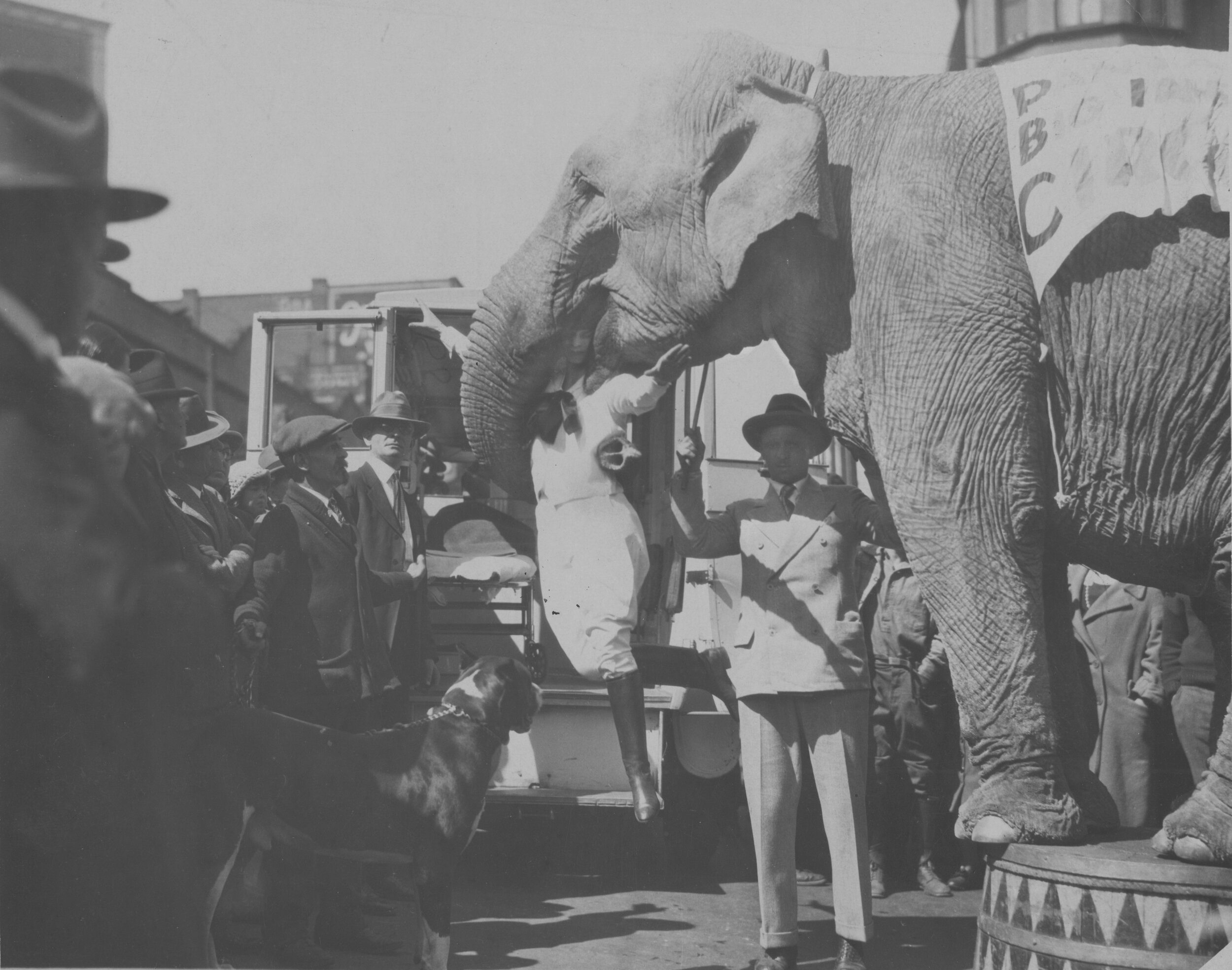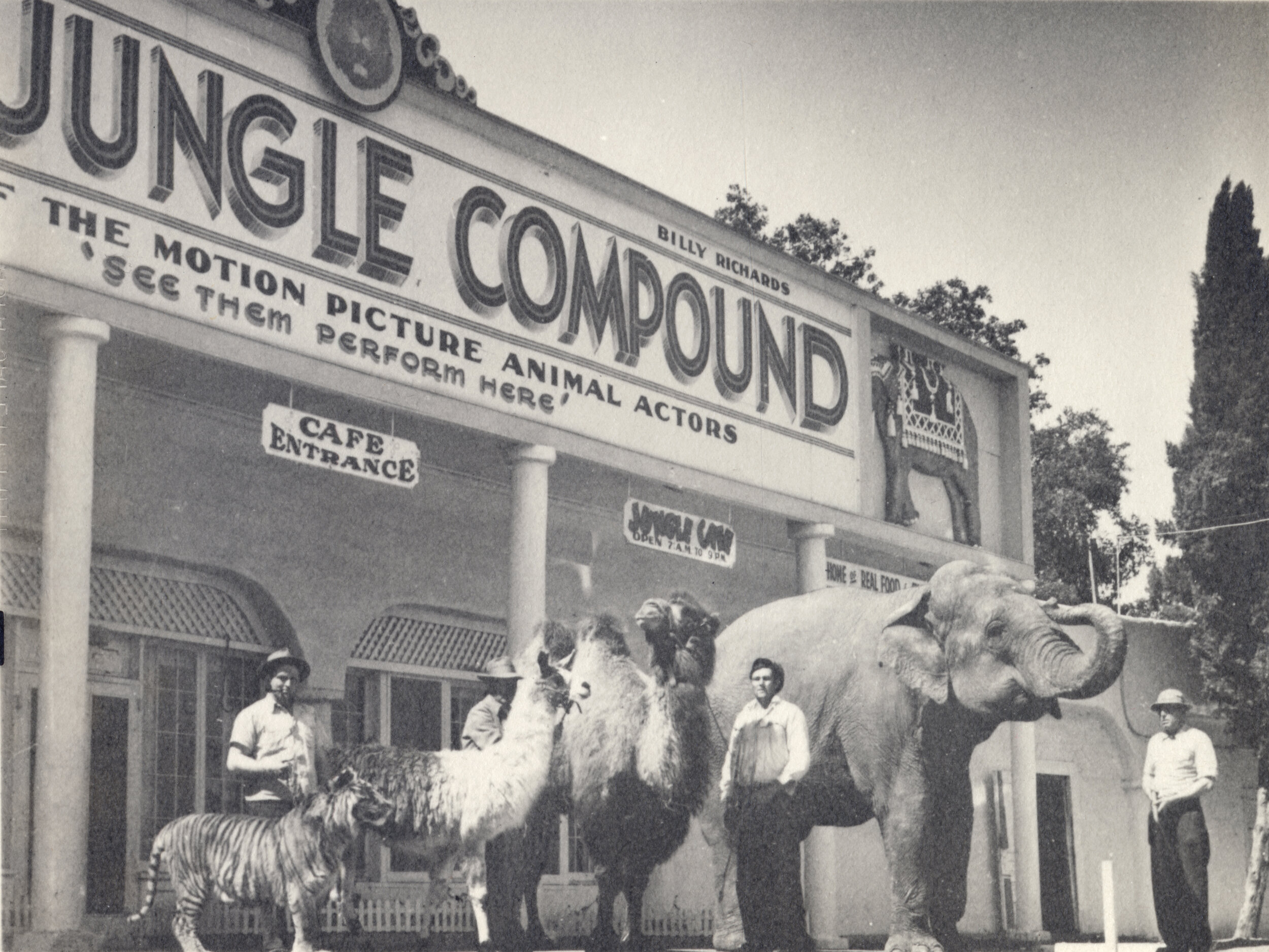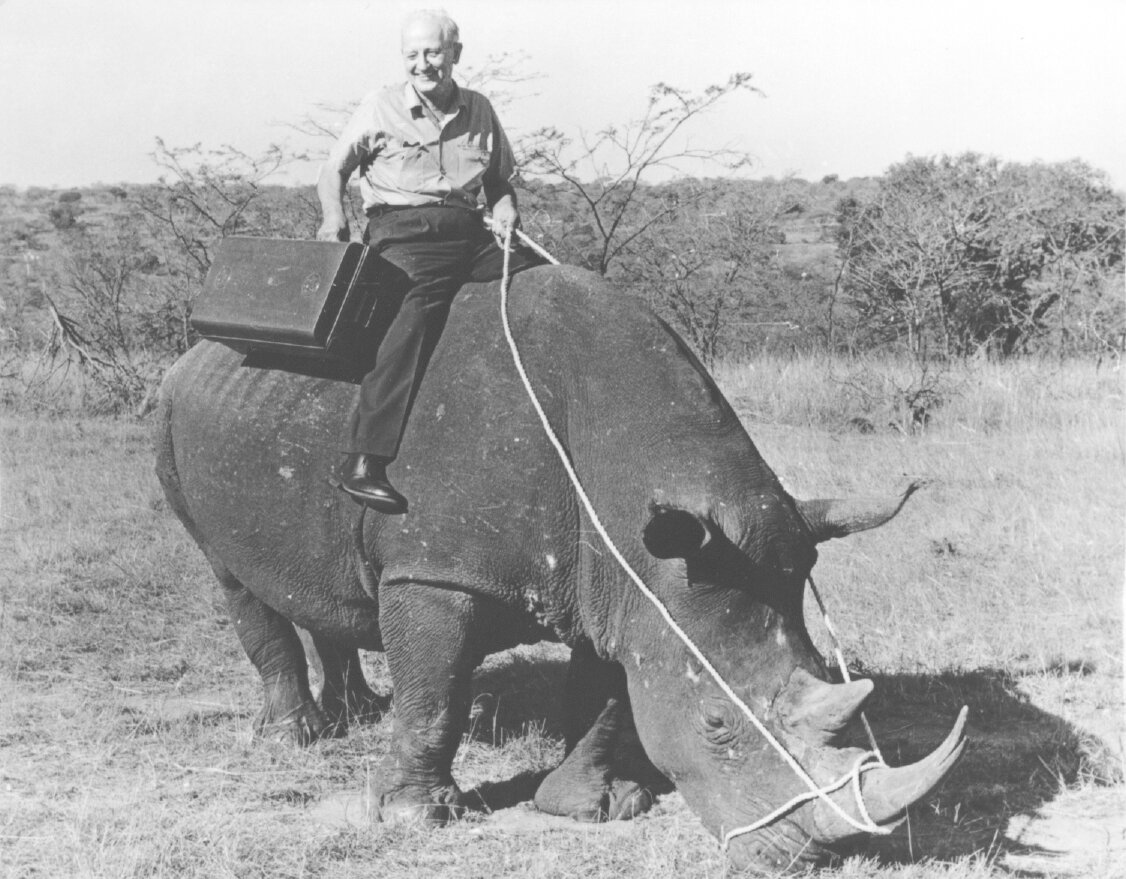"Home of Goebel's African Lions". Admission was 25 cents, 10 cents for children. This view is thought to be soon after the public opening of Goebel’s Lion Farm in 1926.
Jungleland
Originally Goebel’s Lion Farm, then World Jungle Compound, and finally Jungleland, it was one of Southern California’s most popular tourist spots for over forty years
Walter Northrup, with one of the Goebel’s camels. Walter and his brother Earl were keepers at Louis Goebel's Lion Farm (later Jungleland) during the 1930s.
Training Animal Actors
The MGM lion. Mister Ed. Tarzan’s comic sidekick, Cheeta (the chimpanzee). Dr. Doolittle and The Adventures of Robinhood. Goebel’s Lion Farm trained the animal stars for Hollywood.
R to L: Karen, Jayne, and Brian Robertson on the swan boats at Jungeland, 1965. Photo by Mary Jo Robertson.
Amusement Park
Children could ride in the mechanical swan boats or tour the grounds on a live turtle or elephant. There were guided tram tours, and at one point there was even a sky tram. Chucko the Clown entertained at kids’ birthday parties. Exotic animal shows were scheduled throughout the day. Amenities included water fountains shaped as lions and hippos that required you to lower your head into gaping jaws for a drink.
Exotic Animals
Louis and Kathleen Goebel put Thousand Oaks on the map as a place where exotic animals and their trainers, keepers, veterinarians, and other exotic personalities were welcome. Circuses over-wintered on the grounds, and many circus celebrities were associated with the compound.
Jungleland giraffe, 1960s
Louis Goebel was a New York butcher’s son who moved to Southern California in the 1920s and found work at Gay’s Lion Farm near MacArthur Park (there’s another story!). Gay’s Lion Farm was founded by former circus stars who trained lions for motion picture shows, so the job must have provided Goebel with contacts and the background for his future career. He moved on to Universal Studios, preparing meals (his butchering skills were useful) for critters at Universal’s zoo, which housed animals used in Universal’s pictures and, by 1915, was the largest privately owned menagerie in the U.S.
When Universal closed the zoo, Goebel purchased seven of the lions and some smaller animals. Recognizing the potential of animals trained for movie appearances, Goebel looked for land in Los Angeles County but was denied the necessary permits. He went a few miles north, just across the county line into Ventura County where regulations were more relaxed. Scouting out Ventura Road, which stretched through the San Fernando Valley into the Conejo Valley, he came to Barrel Spring (near the former home of Egbert Starr Newbury, Conejo Valley’s original 1870s postmaster) and knew he had found the right property. The site is approximately where the Civic Arts Plaza is today.
Anna Muller with her head inside the mouth of Rosie, the elephant. Rudy Muller, her husband is standing next to Rosie, who wears a sign for the Pan American Big Top Circus. Anna and Rudy were animal trainers and performers who toured the world. They moved to Thousand Oaks in 1946 to work at Goebel's Lion Farm (later known as Jungleland). Look closely: Rosie is holding Anna suspended in mid-air with her trunk!
The place and timing were perfect. After the success of the original Tarzan film, a whole series of Tarzan films were scheduled at nearby Lake Sherwood, with Goebel’s Lion Farm providing all of the animals. Louis continued to buy a variety of exotic animals, constructing new cages as they arrived. His wife, Kathleen, fed and cared for the baby animals born on-site.
More and more “friends of friends” began to come out from the city to visit the animals. Goebel decided to create a trained animal show, open a small restaurant and sell tickets. Initially, Kathleen ran the restaurant and sold show tickets while Louis presented the show. The tourist business was a big hit. Kathleen always felt that guests delighted in watching the baby animals play as much as they liked the trained animal show.
The official opening of Goebel’s Lion Farm as a tourist attraction was 1926. But the Goebels continued to train animals for the movies, supplying Hollywood with 600 animal actors over the years. As importers and exporters of exotic animals, they traveled around the world looking for animals to sell to zoos around the United States. They maintained strong connections with the circus world, providing a location for circuses to spend the winter, and employing circus stars and other personnel. The Goebels operated the tourist show and the animal leasing business for many years, buying more acreage and building more cages as they acquired a wonderful variety of exotic animals. The Goebel Lion Farm became known around the world, both for the animal show and for the magnificently trained exotic animals available for lease to movies and circuses.
World Jungle Compound
After World War II, Goebel sold his business to Billy Richards, a circus man, and Isaac “Trader” Horne, well-known in the animal trade. The name was changed to World Jungle Compound, business continued, and by 1950 the animal farm was a “must see” attraction in California. Thousand Oaks residents often saw trainers walking their animals down the street for a little exercise. Neighbors enjoyed (?) hearing the nightly roar of 40 lions. Robert Miller, DVM who founded the Conejo Valley Veterinary Hospital in Thousand Oaks in the early ‘60s, can tell a tale or two about treating lions, tigers and chimps. He eloquently describes T.O.: “…as we drove through the village, [there] was a great barn labeled “Louis Goebel-Importer and Exporter of Wild Animals.” I saw a garishly painted “World Jungle Compound” and a sign that read “Lion Farm.” There were circus wagons parked in empty lots. Elephants were staked in fields, lions and tigers chained to oak trees.”
"World Jungle Compound." Louis Goebel sold Goebel’s Lion Farm to Trader Horne and Billy Richards in 1946, who renamed it World Jungle Compound. They sold it to Ruman and Rogel in 1956. Tiger, llama, camel and elephant are in front of the entrance, with their trainers. Signage also notes: "the motion picture animal actors" "see them perform here" "cafe entrance" "Jungle Cafe open 7 a.m. To 9 p.m." "home of real food..."
Melvin Koontz was the chief trainer from 1946 to 1964. In 1954 he bore the dubious distinction of being the only trainer at World Jungle Compound who had never been bitten by a chimpanzee.
When Mabel Stark brought her tigers to Goebel’s Lion Farm in 1935 while she recuperated from a mauling accident in the circus ring, she was a national celebrity. Mabel did performances at the Lion Farm after healing, and after WWII resumed touring with her beloved cats. In the 1950s she was talked out of retiring by Louis Goebel and became one of the World Jungle Compound’s main attractions.
The End
In 1956 the business was sold again, this time to two executives of 20th Century Fox Studio, James Ruman and Sid Rogel, and they renamed the park "Jungleland" in hopes of creating a "Disneyland with live animals". In October of 1969, after a few more changes of ownership, Jungleland closed its doors for good and 1800 animals were sold at auction and loaded into trailers. Some ex-Jungleland trainers set up their own animal actor training businesses in the area. The bonds between the trainers and keepers and their animals were strong. A combination of deep love and respect on both sides created partnerships that allowed both two-legged and four-legged creatures to “perform” together. There are still animal actor homes tucked into the back canyons of the Conejo Valley, but its heyday for exotic animal training is over.
Sign at Jungleland details auction of animals and structures to be held Oct. 8 at Thousand Oaks wild animal compound in wake of bankruptcy proceedings. Photo by Darlene Lima.
Acknowledgements: All photos and most of the captions are courtesy of Conejo Through the Lens, Thousand Oaks Library. Much of the text was written by Miriam Sprankling for our Volunteer Handbook. Dr. Robert Miller is quoted from his marvelous book, Yes, We Treat Aardvarks: Stories from an Extraordinary Veterinary Practice, that can be purchased at The Emporium.
Other sources include Lions, Tigers, and the Birth of Thousand Oaks an article by Allison Montroy in Beyond the Acorn, Spring 2016; Popular Mechanics (go figure), March 1954; Popular Media and Animals by Claire Molloy, 2011; and assorted other, sometimes rather weird, articles. There are conflicting dates, numbers and other information out there, but this article should convey the gist of the Goebel/Jungleland story.
The story wouldn’t be complete without pictures of Kathleen and Louis. What a wonderful community it must have been to call home.
Kathleen Goebel
Louis Goebel had a couple of photos taken on a rhinocerous when he was on a collecting trip in the 1950s. Copied by Frank Knight, 1966.
Dr. Robert Miller examines a baby elephant at Jungleland, n.d. Donated by Robert Miller.
And finally, another quote from Dr. Miller: “One Saturday night, after we had lived in Thousand Oaks for a few months, a community dance was held in a circus tent, set up on the Jungleland parking lot. I marveled at the unusual variety of townspeople. There were the Jungleland and circus folk, the ordinary variety of small town people, a sprinkling of writers and a movie director from Lake Sherwood, a couple of film stars who owned ranches in the valley, cowboys from the horse farms and cattle ranches, and hillbilly types, some of whom lived in rundown town residences, and others who had come down from the hills. … As Debby [Miller’s wife] and I looked at the colorful residents of Thousand Oaks, she said, “I wonder if there is another town with such an assortment of characters?”











